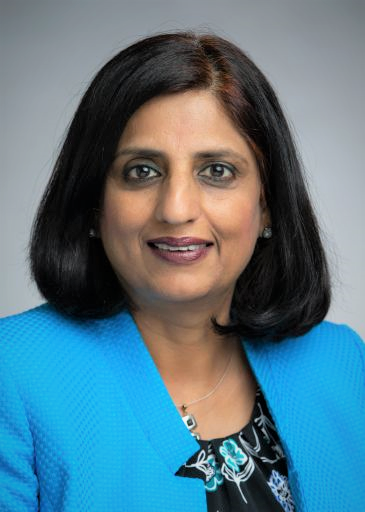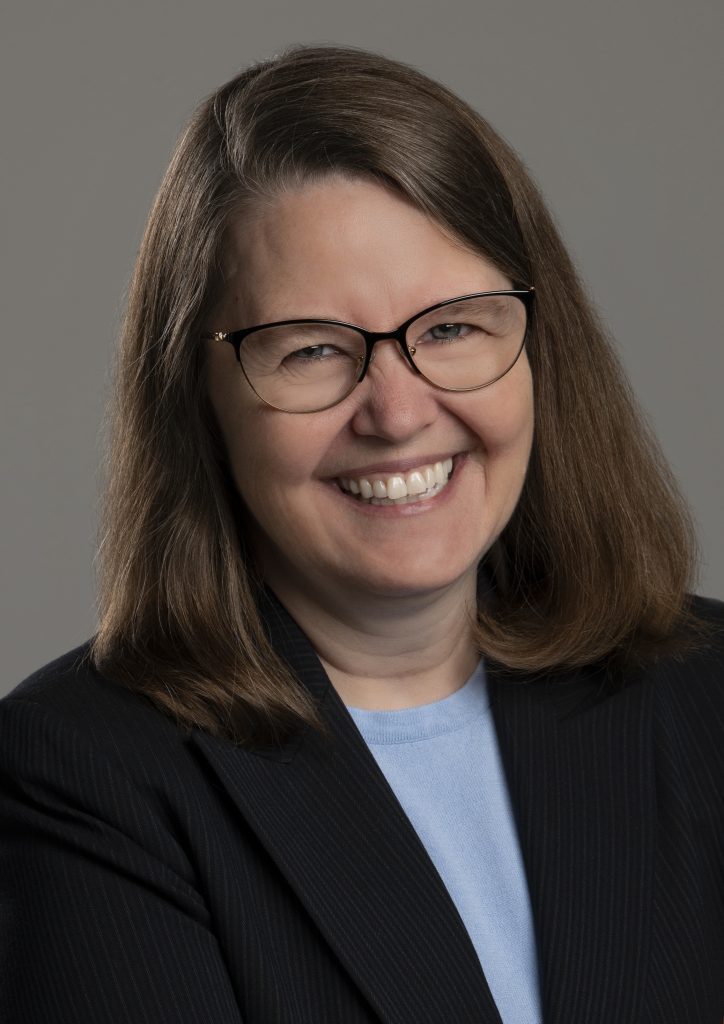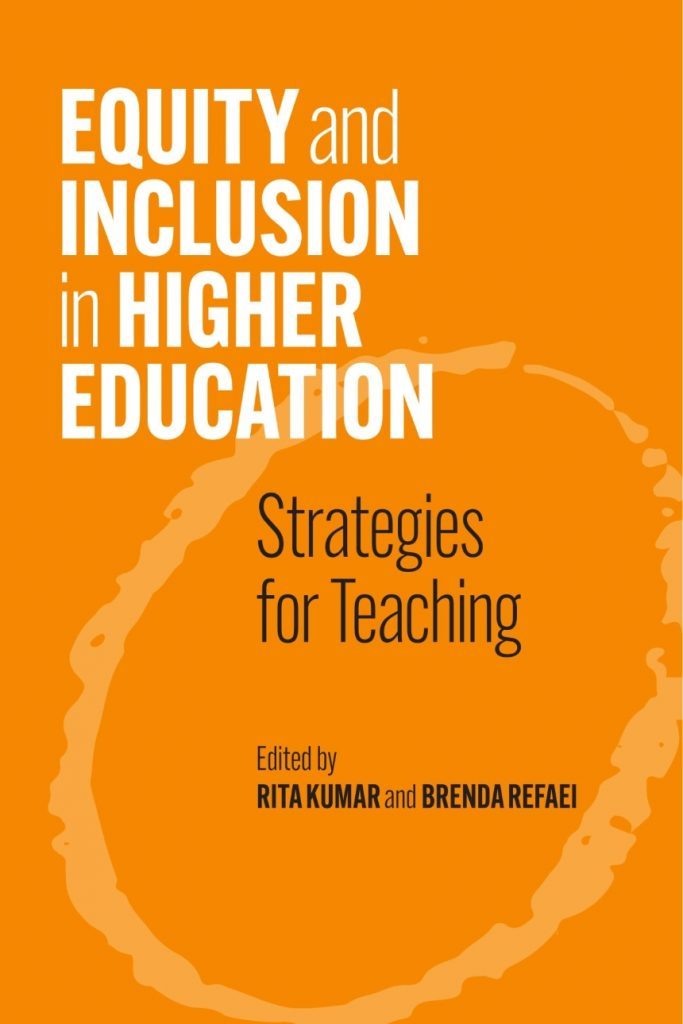On March 24, 2022, Dr. Rita Kumar and Dr. Brenda Refaei moderated a webinar focused on their new edited volume “Equity and Inclusion in Higher Education: Strategies for Teaching.” The session offered faculty attendees the opportunity to reflect on how to adopt pedagogies, curricula and assessment processes to become more inclusive practitioners. This post is a summary of key ideas and outcomes from the session.
Guiding Principles


Dr. Kumar is the Executive Director of the Faculty Enrichment Center at the University of Cincinnati and former Professor of English at the University of Cincinnati Blue Ash. Dr. Refaei is the Director of the Learning + Teaching Center and a Professor of English and Communication at the University of Cincinnati Blue Ash College.
They have both been engaged with issues related to diversity, equity and inclusion (DEI) in teaching for years, during which they have developed a framework for thinking about DEI in teaching. The framework informs the structure of their recently-published book, which includes 15 chapters with reflections and examples from faculty representing multiple disciplines.
Some of the principles which guide Kumar’s and Refaei’s work:
- Intentionality, or a specific attitude that they want to address DEI in their work and personal life.
- Self-awareness of values and beliefs and their influence on course construction and teaching behavior.
- Ongoing commitment to continuing education about DEI concerns.
- A deep desire to promote a more socially-just and inclusive society by working with students and colleagues to create it.
- Actively working to develop resiliency to engage in the ongoing work of DEI.
Engaging in a “Brave Space”
Kumar and Refaei began the webinar by encouraging attendees to create not only a “safe space” in their classrooms for discussing equity issues but also a “brave space,” in which both faculty and students recognize that engaging on these topics can require bravery and a willingness to acknowledge that we all are learning, growing and trying to do better. Within the brave space of the webinar, attendees were asked to anonymously describe some of the principles which guide their own thoughts about DEI in teaching.
Responses included:
- “Ensuring that all of my students feel safe in the classroom so that they can do their best learning”
- “That our clinicians should look like the patients we serve.”
- “Humility – I don’t have [all the] answers.”
- “Learners deserve and need safe, positive, discrimination-free learning environments.”
Inclusive Pedagogy
Kumar and Refaei argued that inclusive teaching is effective teaching, but effective teaching is not necessarily inclusive, because for truly inclusive teaching there must be an “intentional process of transforming the learning environment so that it respects the ways of knowing and being all students bring to the learning situation.” Some other characteristics of inclusive teaching:
- Sustains all members of the classroom community, for example by taking the time to recognize all students’ cultures, home language and norms as equal in value to the dominant culture and norms,
- Works against deficit thinking that views learners from non-dominant cultures and dialects as “deficient” and in need of remediation before they can access the dominant culture’s privileges,
- Offers opportunities to critique and challenge systems of oppression,
- Mindset that learning and teaching are more than a discrete set of techniques, and that education is meant to be transformational rather than transactional.

Some inclusive pedagogies described by the authors in the book include:
- Using supportive course policies, such as: Diversity and Inclusion statements in course syllabi, describing Office Hours policies in more welcoming and relatable terms by calling them “Student Hours” instead, explaining university or course policies in ways students can understand.
- Designing course activities to promote students helping each other.
- Creating opportunities to foster a sense of belonging.
- Facilitating discussion of systemic inequality as it relates to their discipline. For example, in Math, using data that illuminate systemic inequalities while also teaching math and statistical content.
- Role playing and other interactive activities to develop students’ cultural humility and perspective-taking.
- Providing scaffolded instruction. For example, a foreign language instructor provides scaffolding for students formerly on an individualized education plan (IEP) in high school, to help them transition to the learning environment in college.
Some of the inclusive pedagogies identified by session participants included:
- Designing a syllabus with a diversity of authors, especially ensuring that all of the students’ own ethnic, racial, and gender diversities are reflected in the chosen readings; picking a range of case studies; inviting a diverse selection of guest speakers to provide various content expertise and powerful role models,
- Trying to increase scaffolding to help all students succeed on major writing assignments
- Celebrate different ways of knowing, including emotional and heart-centered practices
- Making sure students know that we are open to feedback about our course and willing to make changes in response to their feedback
- Restorative practices
- Incorporate multiple ways for students to ask questions and engage with instructional content, classmates and instructors (including sharing instructor’s cell phone contact number, in one case), and designing activities to promote students helping each other.
Inclusive Curricula
Following the discussion of inclusive pedagogical practices, the webinar turned to consideration of inclusive curricula, and what makes curricula inclusive. Some characteristics of inclusive curricula:
- Technological accessibility (this is a fundamental baseline),
- Relevant to student experiences and reflect student experiences and realities,
- Engaging to all students,
- Provides all students the opportunity to achieve the learning objectives.
The way this looks might be different for “DEI-focused courses,” in which the primary topics and goals of the course are related to DEI and social justice, and for “DEI-infused courses,” in which the course is focused on disciplinary topics, but concepts of equity and inclusivity have been kept intentionally in mind when designing and choosing course activities and materials. Refaei and Kumar emphasized that faculty are responsible for inclusive curricula, and even in cases where faculty may be asked to use a shared, jointly-developed curriculum, faculty have the obligation to point out places where the curriculum should be made more inclusive. They suggested three broad approaches for creating more inclusive curricula:
- Decolonizing the curriculum by recognizing the contributions to the discipline from all races, ethnicities, sexual orientations, etc. and using sources beyond the standard textbook when necessary. Make an ongoing commitment to continuously adjust by not only bringing in marginalized voices, but also by recognizing the ways knowledge in the discipline is taught and actively bringing in different ways of knowing and conceiving of the world.
- Uncovering the hidden curriculum. The “hidden curriculum” is the unwritten and unspoken rules in a class, which are the result of our perspectives and unconscious biases about how university courses “work” and how students “should” learn in a classroom. Uncovering and addressing these requires significant self-questioning and self-awareness.
- Universal Design for Learning: using different types of course materials and activities to address the learning needs of all students.
Kumar elaborated some approaches for selecting inclusive course content, while recognizing that a faculty member’s own “positionality” within the institution may impact how much they can do. For example, a faculty member from a non-dominant or marginalized group, such as a female person of color, may have difficulty adopting inclusive curricula if she doesn’t have the support of her department. Similarly, those who must use a generalized curriculum may not have much control to make changes in their individual course section.
Kumar argued that tenured faculty and those in positions of power have the responsibility to promote inclusive curricula and to support junior and part-time faculty in the work of making curricula more inclusive. Tenured faculty can volunteer for curriculum committees to ensure inclusive curricula are implemented. Kumar made a point that it’s important for students working in the discipline to see DEI principles carried into all courses within the major, not just in scattered or introductory courses.
Inclusive Assessment
When describing approaches they take to make their curricula more inclusive, some of the attendees described offering options for assessment, ensuring that outcomes measures are attainable by all students. Assessment is gathering data about what students are learning, and working with students to improve future learning. A culturally-responsive approach to assessment allows multiple means for students to demonstrate learning, and creates assessments that any student has the potential to successfully complete.
When designing assessments, instructors can challenge themselves to be aware of any “deficit thinking” they may bring, exposing subtle ways they may think about “some students” as not being ready for college work, and how those biases may be reflected in their assessment practices. Refaei and Kumar argued that if a faculty member is not actively working toward socially-just assessments, they are actually continuing to cause harm, even if unintended. This is because many of our assessment practices come from a Eurocentric background that minimizes other ways of knowing and may not fully allow students to reflect and document what they are capable of doing.
The cycle of inclusive assessment includes:
- Planning and identifying outcomes: write learning outcomes with equity-minded assessment in mind, while actively considering and trying to discard biases and assumptions one may make about students. What range of activities will allow students to demonstrate their mastery of course content? Are these activities free of bias? Will they favor one way of knowing over another?
- Design and implement assignments: include opportunities to practice, clearly describe the norms and expectations about the assignments, provide feedback and opportunities to use the feedback to improve, provide different options to complete the assignment, review assignments for culturally-unclear references or wording. Refaei referenced “transparent assignment design” as described on the TILT website as a useful resource.
- Analyze the data: disaggregate data to look at how different demographic groups respond to the assignment, use data to improve the assignment in future iterations.
- Share results: share de-identified data with students, colleagues and others.
- Make changes: improve assignment instructions, timing, grading criteria and other factors in response to data.
Ways that participants mentioned creating more inclusive assignments or assessments included:
- Allowing for choice in assessment options, including several categories of engagement and allowing students to assess themselves throughout the semester.
- Giving opportunities to work on practice exam questions, in similar format and rigor to what students will complete in course exams.
- Having a check-and-balance system in place such that more than one person reviews assessment items with an eye for inclusion.
- Providing variety with group and individual assessments
- Allowing students an opportunity for resubmission with an opportunity to earn back credit.
- Doing a midterm survey asking students how the course could be improved. This allows for adjusting the course midway, before the final assessment.
- Having students brainstorm ideas of how to assess (this faculty member reported that their students have chosen video reflections, discussion boards, written papers, etc.)
- Providing academic coaching to all students to support exam preparation.
- Allowing students to write on topics or complete projects that are of interest to them, and providing clear rubrics or criteria for the assignments.
The webinar concluded with a reminder that DEI work in teaching is on-going. Those who are engaged in the work will need to continually reflect on how they can use their own position within their institutions to advocate to achieve the mission of higher education, and will need to build their own resilience by “putting on their own oxygen mask before aiding others.”
Resources
- Inclusive teaching rubric developed by two of their book authors, Deyu Hu and Michele Deramo, which allows faculty to self-assess their teaching practice against some potential best practices.
- Table to capture and structure DEI development around short-term and longer-term goals and plans.
- Collection of inclusive teaching resources
- Webinar slide deck (pdf)

